This is a nice way to end a year that has been filled with heartache.
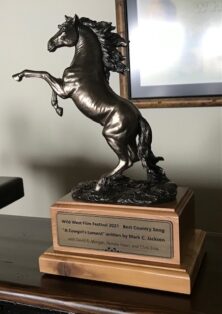
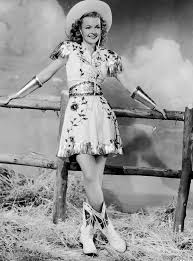
Christmas, my child, is love in action. Every time we love, every time we give, it’s Christmas.
If we never had any storms, we couldn’t appreciate the sunshine.
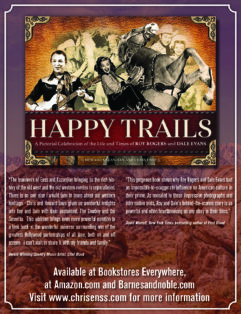
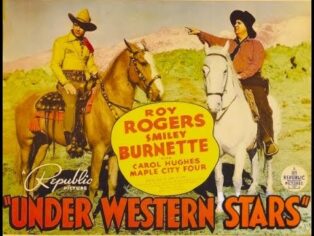
Under Western Stars
An Essay for the National Film Registry
By
Howard Kazanjian and Chris Enss
King of the Cowboys Roy Rogers made his starring motion picture debut in Republic Studio’s engaging western musical Under Western Stars. Released in 1938, the charming, affable Rogers portrayed the most colorful Congressman ever to walk up the steps of the nation’s capital. Rogers’ character, a fearless, two-gun cowboy and ranger from the western town of Sageville, is elected to office to try to win legislation favorable to dust bowl residents.
Rogers represents a group of ranchers whose land has dried up when a water company controlling the only dam decides to keep the coveted liquid from the hard working cattlemen. Spurred on by his secretary and publicity manager, Frog Millhouse, played by Smiley Burnette, Rogers campaigns for office. The portly Burnette provides much of the film’s comic relief and goes to extremes to get his friend elected. His tactics include pasting stickers on the backs of unsuspecting citizens he engages in conversation and helping to organize a square dance to highlight Rogers’ skill and dedication to solving the constituent’s crisis. Using his knowledge of land and livestock and his talent for singing and yodeling, Rogers wins a seat in Congress.
The sweep of this picture, which moves rapidly from physical action on the western plains to diplomatic action in Washington and back again, is distinctively thrilling. The surging climax in the dust-stricken cattle country makes for one of the most refreshing films of its kind. The politicians Rogers appeals to about the drought are not convinced the situation is as serious as they are led to believe and decide to inspect the scene for themselves. The investigation committee is eventually trapped in a real dust storm. The shots of the storm and the devastation left in its wake are spectacular.
Roy Rogers came to Hollywood from Duck Run, Ohio. He made a name for himself as a member of the successful singing group the Sons of the Pioneers. Reigning box office cowboy Gene Autry’s difficulties with Herbert Yates, head of Republic Studios, paved the way for Rogers to ride into the leading role in Under Western Stars. Yates felt he alone was responsible for creating Autry’s success in films and wanted a portion of the revenue he made from the image he helped create. Yates demanded a percentage of any commercial, product endorsement, merchandising, and personal appearance Autry made. Autry did not believe Yates was entitled to the money he earned outside of the movies made for Republic Studios. He refused to include Yates in the profits and threatened to leave the studio if Yates did not reconsider. Autry was also demanding a raise in pay.
Yates decided it was time to begin grooming another talent to take Autry’s place should the need arise. Rogers was a contract player with the studio making $75 a week. Billed as Leonard Slye he appeared in a handful of films with Gene Autry singing along with the Sons of the Pioneers. Rogers even had a part as a bad guy in one of Autry’s films. When Autry caught up with Rogers in the picture, instead of taking him to jail he demanded the wily character yodel his way out of his troubles.
Yates had been looking for a musical actor to go boot-to-boot with Autry and Rogers was to be the heir apparent. His sweet, pure voice and wholesome image made him a natural for the hero in Under the Western Stars. Whether regaling the audience with a song about fighting the law entitled Send Our Mail to the County Jail or delivering a stump speech via a tune called Listen to Rhythm of the Range, Rogers makes the most of his leading role.
The Maple City Four, the well-known quartet who made the number Git Along Little Dogies popular, added their talents with Rogers harmonizing on the film’s most important song entitled Dust. Written by Johnny Marvin, a recording artist from Oklahoma, Dust was nominated for an Academy Award for Best Original Song. It was the first song from a B-western to be Oscar nominated.
According to the February 24, 1938, edition of the Hollywood Reporter, Dust was purchased by Republic Studios from the composers, Gene Autry and Johnny Marvin, for use in Under Western Stars. A subsequent news item in Hollywood Reporter on April 13, 1938, just prior to the film’s release, noted that Autry was suing the studio for $25,000 for unauthorized use and dramatization of the lyrics with Dust. According to contemporary sources, the suit over Dust was settled out of court and Johnny Marvin is listed as sole writer of the song.
Audiences made Under Western Stars a box office success and critics called its star “the new Playboy of the Western World.”
Director Joseph Kane, Republic’s top director of westerns delivered a film with a slight new slanting to make it different from all other B-westerns before it. In addition to the political intrigue in Under Western Stars there is a fair amount of gunfights, fast horses, and unforgettable stunts. What makes Kane’s film unique is that the fight is not over horse thieves, but the rights of man. Critics at the Brooklyn Daily Eagle newspaper sited Kane’s “sensitive directing eye with giving the horse opera a social consciousness.”
Actors Carol Hughes, Guy Usher, Tex Cooper, Kenneth Harlan, Curley Dresden, Bill Wolfe, Jack Ingram, Jack Kirk, Fred Burns, and Tom Chatterton round out the exciting cast of players and no happy ending would be possible at all if not for Roy’s magnificent Palomino horse Trigger. Brothers and veteran western writers Dorrell and Stuart McGowan penned the screenplay for Under Western Stars along with actress and screenwriter Betty Burbridge.
The film was shot in the Alabama Hills of Lone Pine, California. The scenic location has been used for the backdrop in hundreds of motion pictures and television programs. The high desert surroundings are integral to the story line of Under Western Stars and could be billed as a supporting role in the film.
Roy Rogers’ first starring vehicle solidified his place as a rising star in B westerns. Film writer and critic Louella Parsons likened Rogers to “Gary Cooper in personal appeal.” According to her report with the International News Service on November 29, 1938, she called Rogers an “upstanding young American who made the picture Under Western Stars a delight.”
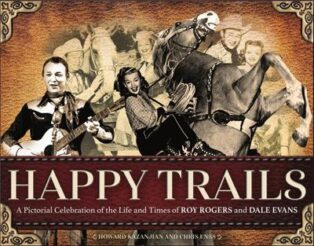
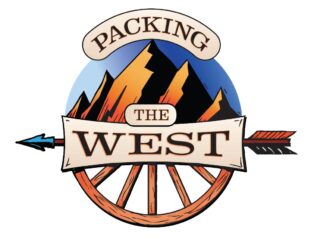
This spring I met with a handful of California State Board of Education members to discuss Packing the West and learn the criteria to be followed when writing the Gold Rush curriculum for the program. Some of the meetings were held in elementary school classrooms after students had left for the day. Being in that setting brought back a flood of memories, primarily of one of the teachers who helped spark my desire to write.
Dr. Augustus Bock was my high school English teacher. He loved the flirtatious tango of consonants and vowels, the steady dependability of nouns and the capricious whimsy of verbs, the strutting pageantry of the adjective and the flitting evanescence of the adverb, all kept safe and orderly by those reliable little policemen, punctuation marks. He wanted to write the great American novel and when that didn’t happen, he turned to teaching. Most of the time his passion for the vocation was infectious, but there were weeks when it was clear he believed he’d settled. It was then that the tweed jacket with suede patches at the elbows he always wore appeared as if he’d slept in it, and he started to smell like cherry pipe tobacco and defeat. I guess he didn’t understand how much his students valued him even if he never penned his version of East of Eden.
The same couldn’t be said for my British literature teacher, Evelyn DeLagrange, an Amazonian-looking woman with long red hair and an unnatural obsession with Geoffrey Chaucer. Our troubles began after she read a book report I’d written about The Canterbury Tales in which I noted that “Chaucer was an expert at making nothing happen slowly.” In a meeting Ms. DeLagrange had with my parents at the end of the semester, she suggested they take the college money they’d been saving for me and buy themselves a fishing boat because the only college she thought I’d be able to attend would have the word “beauty” or “clown” in front of it.
But I showed her. After two years studying journalism at Cochise College, in Sierra Vista, Arizona, I went on to attend the University of Arizona, where I majored in drama. When you tell someone you majored in drama, the first thing they do is mentally subtract twenty grand off what they think you make for a living. The second thing they do is ask you to bring them a menu and tell them about the soup for the day.
Some teachers make a person want to become a writer, scientist, historian, etc., because they love the subjects they teach, and that ignites a desire in their students. Other teachers drive students to their life’s pursuit just to prove that they were meant to do more than wear a multicolored wig, a rubber nose, and a massive bow tie. And that brings me back to Packing the West. With the Packing the West program, we hope to not only stir in students a love for the American West but to encourage them to strive for more, in the same way that the men and women on the frontier did. We’re just getting started, but the historical figures we’ve included in the first set of learning materials for youngsters are impressive. With Nat Love, Louisa Clappe, William Bent, Mary Graves, Buffalo Bill Cody, and Jim Bridger as teachers, anything is possible. And that should be the mantra for every teacher.
*Note to Buena High School Friends – Evelyn DeLagrange is not the real name of the teacher in the story. The name has been changed to protect Chaucer.
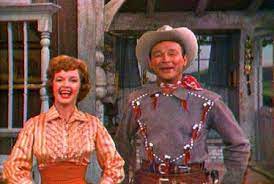
Dale Evans and Roy Rogers are such icons of the American West – quintessential cowgirl and cowboy – that sometimes it is difficult to remember that their personas were media creations and not the real thing. Neither of them grew up riding the range. Dale Evans, born Frances Smith, was married as a young teen-ager, and then left to struggle as a single mother. Roy Rogers, originally Leonard Slye, grew up on a hard-scrabble farm.
Talent and the Hollywood machine transformed them into stars. They married after Rogers was left a widower with small children. Tragedy – and the triumph over it – didn’t stop there. Both adoptive and natural parents, they endured the sad loss of three of their children over the years.
Rogers and Evans managed to project an image of wholesomeness decade after decade over changing times.
Statistics of an American Icon
According to the Roy Rogers Corporation, the total revenue from the sale of Roy Rogers merchandise for 2015 was $14.4 million dollars.
In 2020 the Roy Rogers/Dale Evans official website had more than 912,000 visitors a month.
Ebay Auctions lists the Roy Rogers/Dale Evans memorabilia page as one of their most popular sites. More than 12,000 items are bought and sold a month.
Roy Rogers and Dale Evans made eighty-one westerns for Republic Studios.
The Roy Rogers Show was among the top NBC television programs from 1951 to 1957.
In 1947 alone Roy Rogers received more than 900,000 fan letters.
In 1953 alone 408,000 pairs of Roy Rogers slippers, 900,000 lunch kits, and 1,203,000 jeans and jackets were sold.

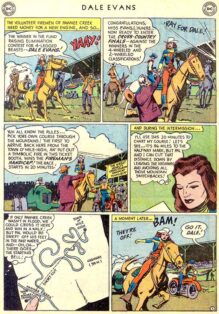
Although she racked up thousands of hours of radio time, made scores of movies, and appeared for many years on television, Dale fell somehow short of traffic-stopping celebrity status. Dale Evans comic never sold quite as well as the Roy Rogers series. The Dale Evans watch never buckled around as many little wrists as the Roy model did. Trigger, Roy’s four-legged friend, rated co-star billing as “The Smartest Horse in the Movies,” Dale’s amazing mounts, Pal and later Buttermilk, sometimes didn’t get recognized until a film’s final credits rolled. Still, for a generation of Americans, those boys and girls who spent the Saturday mornings of their childhoods in the popcorn scented darkness of the local picture show, Dale Evans – fearless, loyal, outspoken, hard-working, pretty – remains cowgirl incarnate. When we think cowgirl, we conjure images of the Queen of the West.

Read all about the life and times of Dale Evans in Happy Trails: A Pictorial Celebration of the Life and Times of Roy Rogers and Dale Evans. Visit www.chrisenss.com to enter to win a copy for Christmas!

“The teamwork of Enss and Kazanjian bringing us the rich history of the old west and the old western movies is unparalleled. There is no one else I would turn to learn about our western heritage. Chris and Howard have given us wonderful insights into Roy and Dale with their acclaimed, The Cowboy and the Senorita. This addition brings even more powerful emotion to a look back at the wonderful universe surrounding one of the greatest Hollywood partnerships of all time, both on and off screen. I can’t wait to share it with my friends and family.” Award Winning Country Music Artist, Clint Black
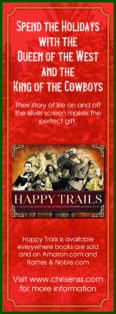
“This gorgeous book shows why Roy Rogers and Dale Evans had an impossible-to-exaggerate influence on American culture in their prime. As revealed in these impressive photographs and informative texts, Roy and Dale’s behind-the-scenes story is as powerful and often heartbreaking as any story in their films.”
David Morrell, New York Times bestselling author of First Blood
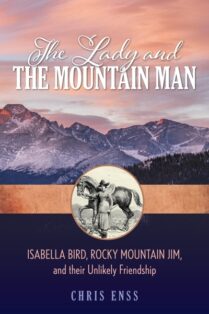
“Isabella Bird is one of Colorado’s favorite historical figures. The fearless Englishwoman rode all over Colorado’s mountains in 1873, in bad weather and by herself. “The Lady and the Mountain Man” is a definitive treatment of Bird’s life.
Bird was an invalid, and doctors recommended sea voyages to improve her health. She was intrigued with the American West, and once healed, she came here by herself to explore the mountains. She settled in Estes Park where she met infamous mountain man Jim Nugent. Mauled by a grizzly, Mountain Jim was scarred and missing an eye, but Bird found him handsome. He had a reputation for violence, particularly when he was drunk, and Bird was warned against him.
The two fell in love, but a future together was not to be.
In this detailed account of the star-crossed lovers, the author — who is known for her books on Western women — plumbs both Colorado and British resources. In Enss’ hands, Bird is not a female oddity, but a woman of strength, courage and loyalty.”

Dale Evans was born Frances Octavia Smith on October 31, 1912, in Uvalde, Texas. In her words, her upbringing was “idyllic.” As the only daughter of Walter and Betty Sue Smith, she was showered with attention and her musical talents were encouraged with piano and dance lessons.
While still in high school, she married Thomas Fox and had a son, Thomas Jr. The marriage, however, was short-lived. After securing a divorce, she attended a business school in Memphis and worked as a secretary before making her singing debut at a local radio station. In 1931 she changed her name to Dale Evans.
By the mid-1930s, Dale was a highly sought-after big-band singer performing with orchestras throughout the Midwest. Her stage persona and singing voice earned her a screen test for the 1942 movie Holiday Inn. She didn’t get the part, but she ended up signing with the nationally broadcast program the Chase and Sanborn Hour and soon after signed a contract with Republic Studios. She hoped her work in motion pictures would lead to a run on Broadway doing musicals.
